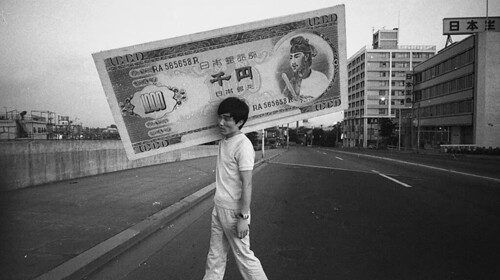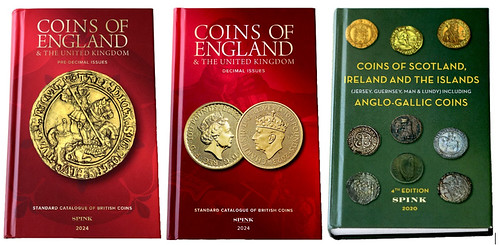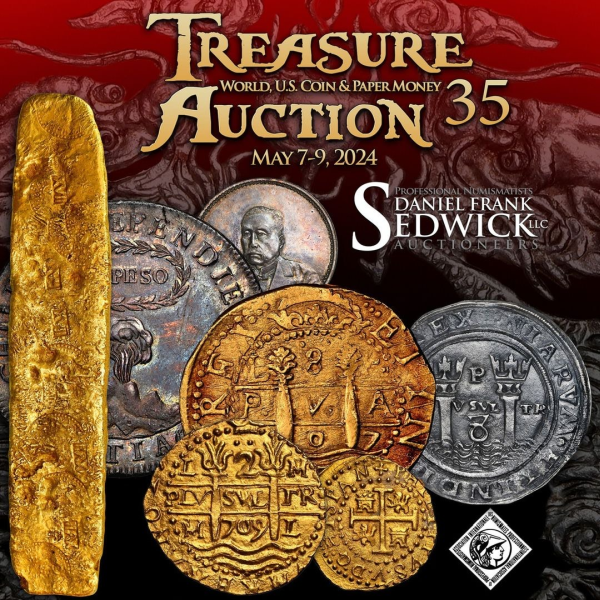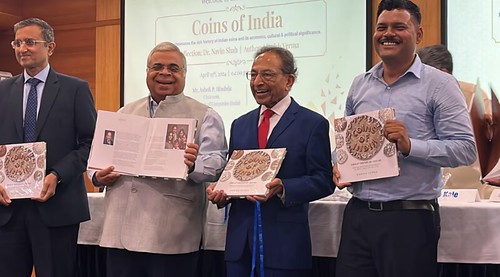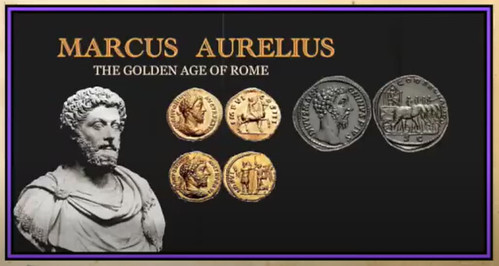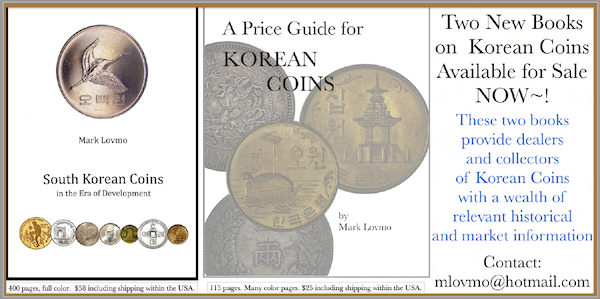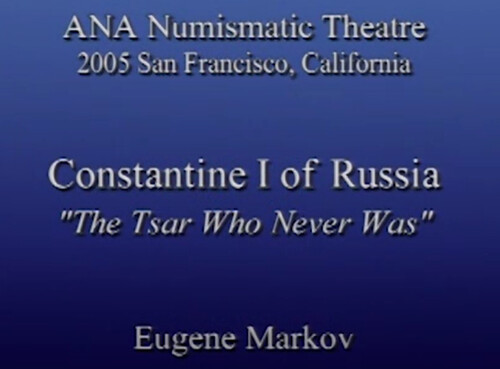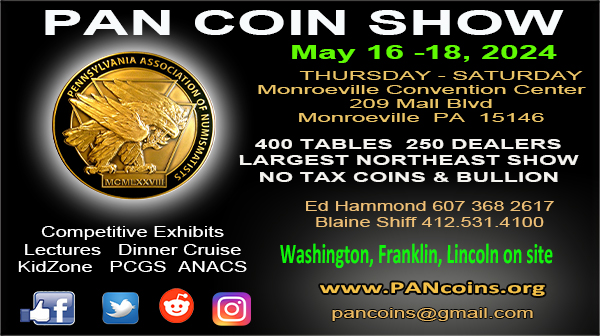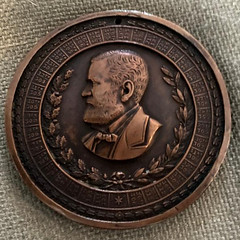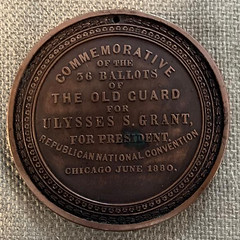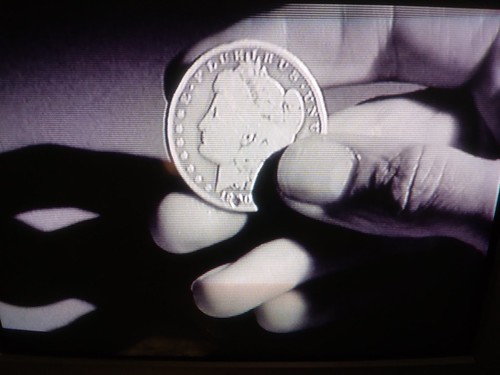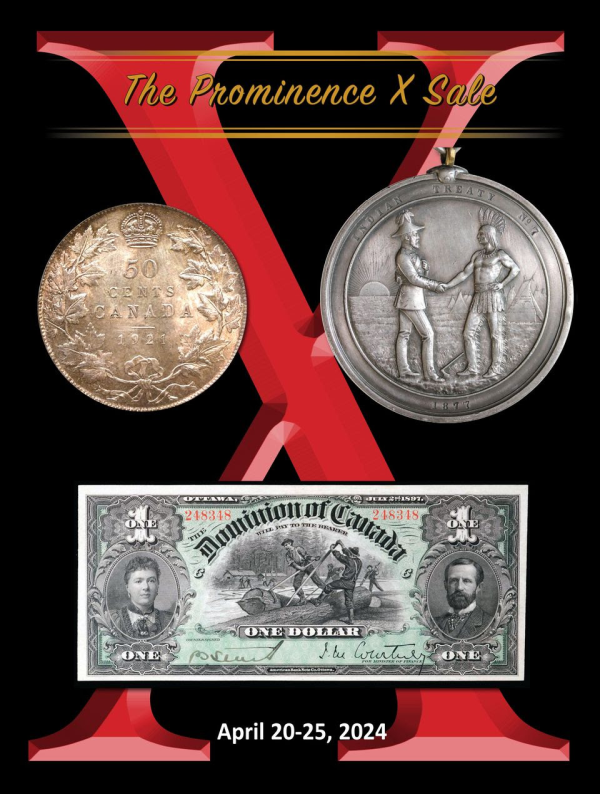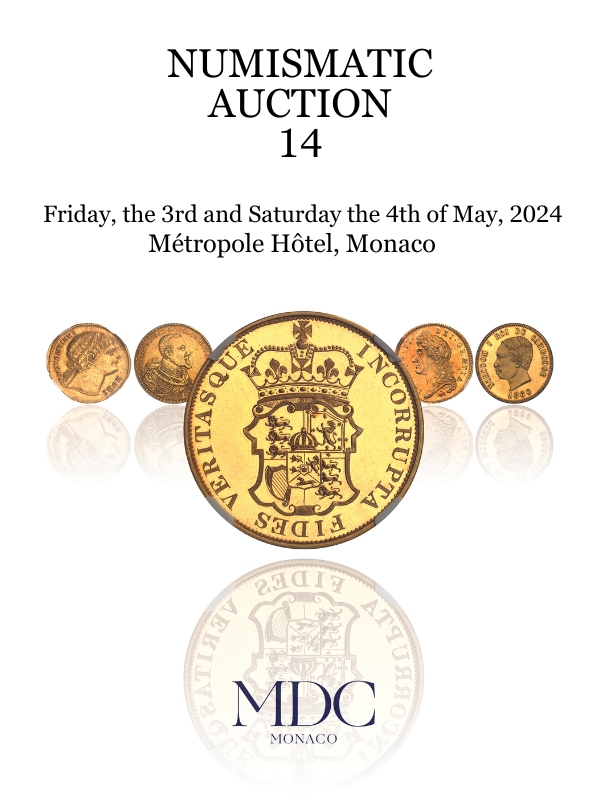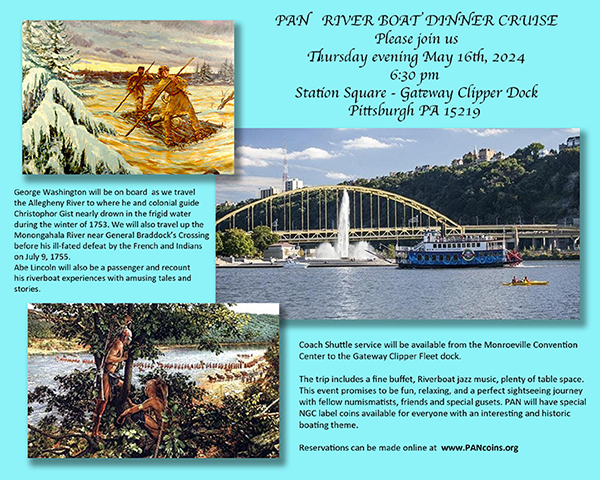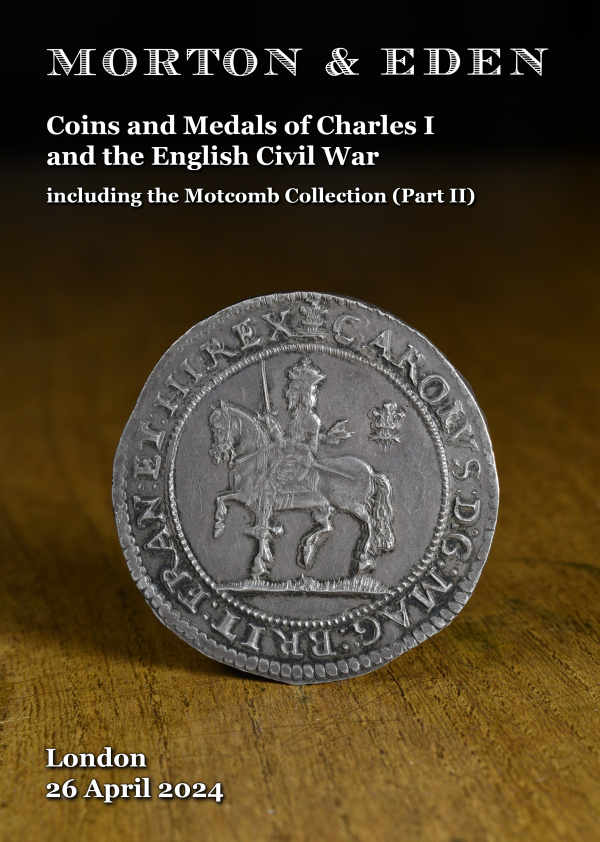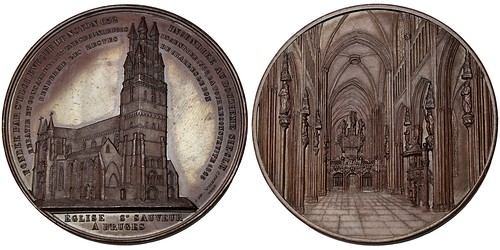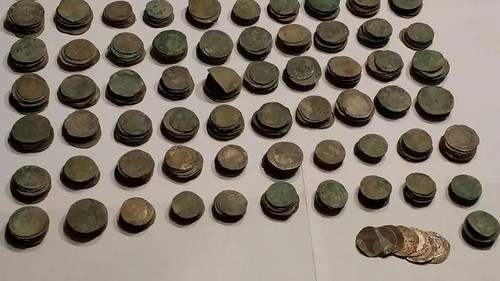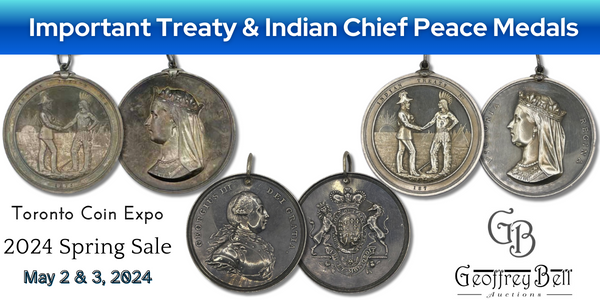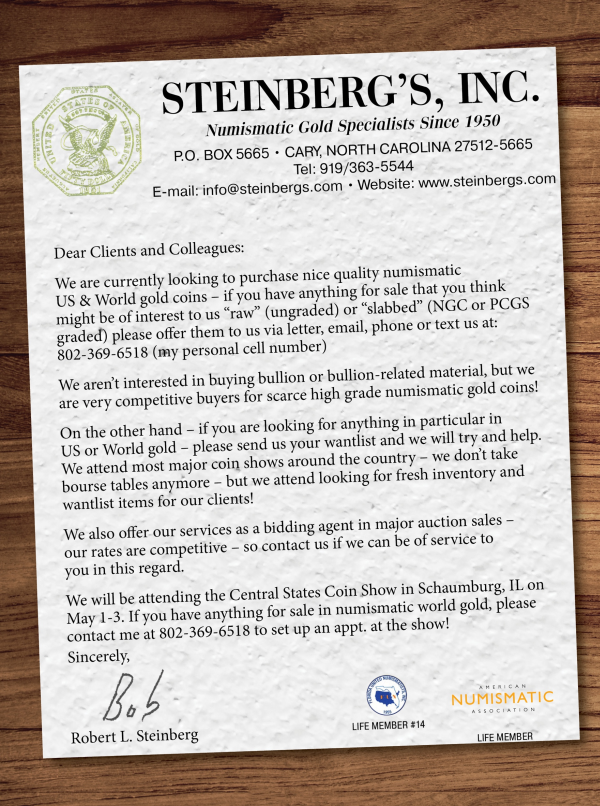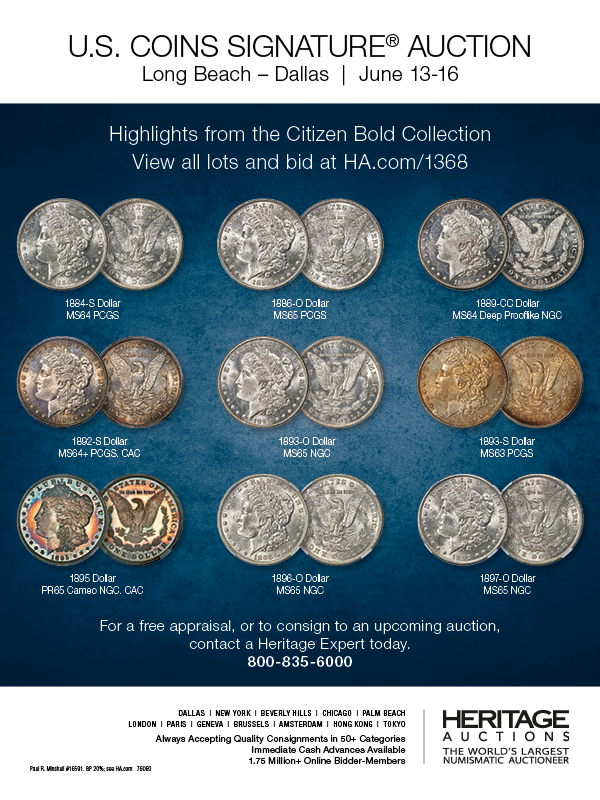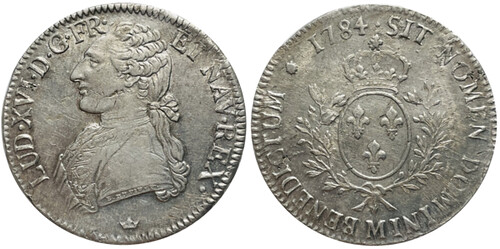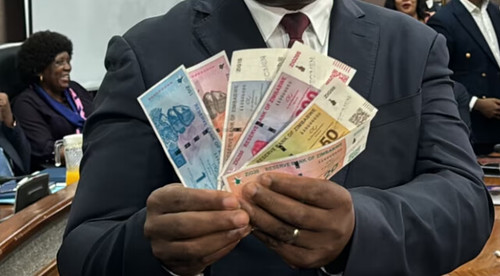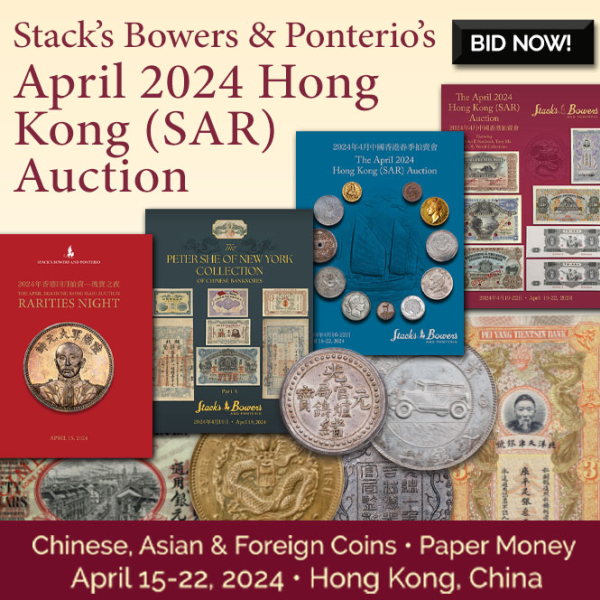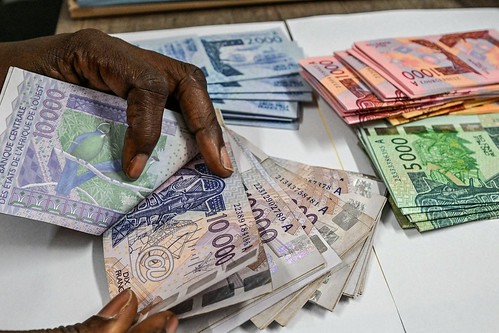
Visit our NBS Sponsors




About UsThe Numismatic Bibliomania Society is a non-profit association devoted to the study and enjoyment of numismatic literature. For more information please see our web site at coinbooks.org SubscriptionsThose wishing to become new E-Sylum subscribers (or wishing to Unsubscribe) can go to the following web page link MembershipThere is a membership application available on the web site Membership Application To join, print the application and return it with your check to the address printed on the application. Print/Digital membership is $40 to addresses in the U.S., and $60 elsewhere. A digital-only membership is available for $25. For those without web access, write to: Jeff Dickerson, Treasurer AsylumFor Asylum mailing address changes and other membership questions, contact Jeff at this email address: treasurer@coinbooks.org SubmissionsTo submit items for publication in The E-Sylum, write to the Editor at this address: whomren@gmail.com BUY THE BOOK BEFORE THE COINSale CalendarWatch here for updates! |
- WAYNE'S WORDS: THE E-SYLUM APRIL 21, 2024
- SOVEREIGN RARITIES ACQUIRES SPINK PUBLICATIONS
- NEW BOOK: NEW ZEALAND CATALOGUE 2024
- NEW BOOK: COINS OF INDIA
- NEW BOOK: 1920 UPPER SILESIAN EMERGENCY MONEY
- ST. LOUIS ANCIENT COIN STUDY GROUP VIDEOS
- VIDEO: CONSTANTINE I OF RUSSIA
- MORE ON THE GRANT REUNION BOOK AND MEDAL
- REVISITING NUMI
- NOTES FROM E-SYLUM READERS: APRIL 21, 2024
- ACEF TO LAUNCH SOCIAL MEDIA CAMPAIGN
- VOCABULARY TERM: PINBACK
- OSCAR GOTTLIEB SCHILKE (1903-1965)
- CINCINNATI COLLECTOR HENRY CLAY EZEKIEL
- SBG ACQUIRES WORLD BANKNOTE AUCTIONS
- DONIVAN FLOYD WINS 2024 PNG SCHOLARSHIP
- NUMISMAGRAM MEDAL SELECTIONS: APRIL 21, 2024
- WAYNE'S NUMISMATIC DIARY: APRIL 21, 2024
- DORSET ENGLISH CIVIL WAR COIN HOARD
- COLLECTING COINS FROM TRASH
- PAVING A FLOOR WITH COINS
- GOLD, SILVER, AND THE ELUSIVE GOLD STANDARD
- NEPAL CROP MAKES JAPANESE BANKNOTE PAPER
- ZIMBABWE GOLD NOTES INTRODUCED
- SINGAPORE STARTUP'S PHYSICAL BITCOIN BANKNOTES
- THE HISTORY AND FUTURE OF THE CFA FRANC
- NEW PORTRAIT IDEAS FOR U.S. CURRENCY
- JAPANESE MONEY ARTIST KATSUHIKO AKASEGAWA
- LOOSE CHANGE: APRIL 21, 2024
- THE BUTTON MUSEUM
Content presented in The E-Sylum is not necessarily researched or independently fact-checked, and views expressed do not necessarily represent those of the Numismatic Bibliomania Society.
WAYNE'S WORDS: THE E-SYLUM APRIL 21, 2024
 New subscribers this week include:
Mark Morris of CoinCraft via Richard Lobel,
Ian Goldbart of Sovereign Rarities via Steve Hill,
and Bob Conrad.
Welcome aboard! We now have 7,283 subscribers.
New subscribers this week include:
Mark Morris of CoinCraft via Richard Lobel,
Ian Goldbart of Sovereign Rarities via Steve Hill,
and Bob Conrad.
Welcome aboard! We now have 7,283 subscribers.
Thank you for reading The E-Sylum. If you enjoy it, please send me the email addresses of friends you think may enjoy it as well and I'll send them a subscription. Contact me at whomren@gmail.com anytime regarding your subscription, or questions, comments or suggestions about our content.
This week we open with a book publishing deal, three new books, updates from the Newman Numismatic Portal, notes from readers and more.
Other topics this week include coins of New Zealand and India, fighting numismatic counterfeiters, pinbacks and buttons, Oscar Schilke, Henry Clay Ezekiel, architectural medals, an English Civil War coin hoard, finding (lots) of coins in trash, and the CFA Franc.
To learn more about Coins of England, the St. Louis Ancient Coin Study Group, the Tsar who never was, AI coin grading progress, America’s Foreign Coins, Augustus Sage's Catalog No. 1, the 1793 Siege of Lyon, making paper for Japanese banknotes, and Japanese money artist Katsuhiko Akasegawa, read on. Have a great week, everyone!
Wayne Homren
Editor, The E-Sylum
SOVEREIGN RARITIES ACQUIRES SPINK PUBLICATIONS
Three iconic publications on U.K. coinage have been acquired from SPINK by Sovereign Rarities Ltd. Here's the announcement. -Editor
Coins of England & the United Kingdom, Decimal Issues
Coins of Scotland, Ireland and the Islands, including Anglo-Gallic Coins
As of 16th April 2024 Sovereign Rarities Ltd, London, UK, has acquired the above three publications from Spink & Son Ltd, who in turn acquired the publications in 1997 from B. A. Seaby Ltd.
B A Seaby had originally produced a more basic one volume catalogue dating from the late 1920s, expanding to Scottish and Irish later on.
NEW BOOK: NEW ZEALAND CATALOGUE 2024
Renniks is offering the new edition of The John Bertrand New Zealand Coin and Banknote Catalogue. Here's the information from their site. The book may be available elsewhere as well. -Editor
The John Bertrand New Zealand Coin and Banknote Catalogue 2024
$24.95
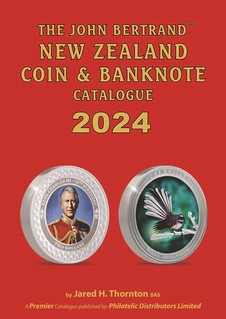 This catalogue features important information regarding all New Zealand coins issued from 1933 and includes values with retail prices given in five grades for the pre-decimal issues. A full listing of decimal issues is also included.
This catalogue features important information regarding all New Zealand coins issued from 1933 and includes values with retail prices given in five grades for the pre-decimal issues. A full listing of decimal issues is also included.
The 2024 edition is edited by Jared H. Thornton and contains many revisions and price updates for new and previous coin issues.
The catalogue contains a “Checks, Discount & Special Purpose Tokens” section, courtesy of Martin Purdy FRNSNZ, and again includes five pages of information on all the major coin “varieties”, also compiled by Martin Purdy, all being shown with values in the category pages. New Zealand banknotes are covered from 1934 to present with prices given in up to six grades, including first and last prefixes.
NEW BOOK: COINS OF INDIA
A new book has been published on the coins of India. Unfortunately, these articles don't mention where to purchase a copy. -Editor
Hinduja Group chairman Ashok Hinduja launched a book ‘Coins of India’ based on Indian American numismatist Dr Navin Shah’s collection of over 2600 rare coins spanning 600 BC to 2022 AD representing several dynasties, Mughals and British rule.
The treasure trove of coinage from 600 BC to post-independence of India has been researched, documented and compiled into the book by author and archaeologist Manish Verma. The book includes important maps to understand the territories of the dynasties and rulers of the rich Indian history.
“History in India has no monetary value. India has not preserved its rich and glorious cultural legacy for the new generation. No one seems to be interested in the intrinsic value of the coins and their rule in history and culture,” rued Dr Shah.
NEW BOOK: 1920 UPPER SILESIAN EMERGENCY MONEY
Here's a Google-translated version of a Geldscheine-Online article on a new book about 1920's notgeld in the Upper Silesia region of Poland. -Editor
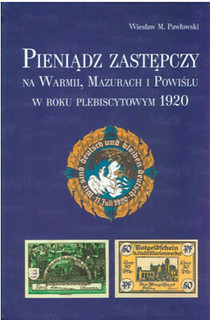 Wieslaw M. Pawlowski:
Wieslaw M. Pawlowski:
Pieniadz Zastepczy na Warmii, Mazurach i Powislu w Roku Plebiscytowym 1920
144 pages, illustrated throughout in color,
Format 165 mm x 240 mm, hardcover with thread binding, Lublin 2023,
Price: 35.00 euros.
ISBN 978-83-945629-8-4.
The book title is translated as “Replacement money in Warmia, Masuria and West Prussia in the plebiscite year 1920”. The author, who has already become known to us through his catalog about the Upper Silesian emergency money, presents another work on German-Polish notaphilia with the new catalog.
A short introductory text explains what the vote in East Prussia was all about. The banknotes from 19 municipalities as well as a coin issue will be presented.
Although the book was written in Polish, you do not need any knowledge of the Polish language or a dictionary to work with it. For each place of issue, the German community name is given first and then the current Polish one.
ST. LOUIS ANCIENT COIN STUDY GROUP VIDEOS
The latest addition to the Newman Numismatic Portal is a group of St. Louis Ancient Coin Study Group videos. Project Coordinator Len Augsburger provided the following report. -Editor
St. Louis Ancient Coin Study Group Videos on Newman Portal
The Newman Portal has added videos of meetings of the St. Louis Ancient Coin Study Group, covering the years 2021-2024. Presentation topics range from ancient to medieval coinage and include a wide variety of speakers. A recent presentation, by Chip Vaughn, focused on coinage under Marcus Aurelius and illuminates ancient Roman history using the numismatics of the period. This group meets monthly in St. Louis, on the third Thursday.
Image: Slide from the Chip Vaughn presentation to the St. Louis Ancient Coin Study Group, February 2024
VIDEO: CONSTANTINE I OF RUSSIA
The David Lisot Video Library on the Newman Numismatic Portal can be found at:
https://nnp.wustl.edu/library/multimediadetail/522852
We highlight one of his videos each week in The E-Sylum. Here's one from 2005 with Eugene Markov speaking about the 1825 Russian coins of Grand Duke Constantine Pavlovich. -Editor
MORE ON THE GRANT REUNION BOOK AND MEDAL
Jerry Nashorn submitted these notes on the medal discussed last week, honoring the Grant Re-Union Dinner for the Old Guard of the 306 delegates who stuck with Grant until the bitter end of the 1880 Republican National Convention. Thanks. -Editor
I can provide some additional information concerning the 1893 booklet that includes medals relating to the 1880 Republican convention. The medal is an electrotype that was produced in1880 or 1881 and distributed to the Old Guard delegates who supported Grant. According to an 1888 article that originated with a St. Louis newspaper and was reprinted by the New York Times, the medal was the brainchild of two prominent Grant supporters, Senator Don Cameron of Pennsylvania and Chauncey Filley, a former mayor of St. Louis. An encyclopedia of Missouri history published in 1901 and available on Google books also has an entry concerning the medal. According to this source, Cameron paid for the medals while Filley arranged for its production by the James Kershaw engraving company of St. Louis, including securing from Grant an up to date photograph to be used for the portrait.
The versions of the medal given to the Grant loyalists, as opposed to those used in 1893, are engraved with the name of the recipient. Attached is a photo of an example I bought on eBay a number of years ago. It was presented to John J. Meigs, who had been a delegate from Elko County, Nevada. Meigs was born in Vermont in 1838. He graduated from Harvard Medical School in 1860 and served as a surgeon in a Vermont regiment during the Civil War. At some point afterwards, he settled in Nevada but by the mid 1890s, he had moved to Oakland where he lived until about 1910. He spent the remaining years of his life in Stockton, dying in 1922.
REVISITING NUMI
Justin Hinh created an app using OpenAI's ChatGPT4 platform to provide coin identification and grading estimates. He submitted this update, which examines improvements in its grading performance. Thanks - very interesting. -Editor
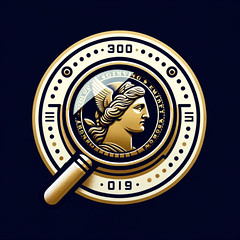 As a coin collector and technology nerd, in late 2023 I developed Numi,
an AI-powered chatbot that leverages the advanced capabilities of
OpenAI's GPT-4 vision model to assist coin collectors in identifying
and grading their coins. It's been fascinating seeing the exponential
growth of Artificial Intelligence, so I created Numi to test AI's abilities to tackle one of the biggest barriers to new collectors in coin
collecting. Throughout Numi's development, I became more and more
convinced that AI is going to fundamentally change the future of the
hobby.
As a coin collector and technology nerd, in late 2023 I developed Numi,
an AI-powered chatbot that leverages the advanced capabilities of
OpenAI's GPT-4 vision model to assist coin collectors in identifying
and grading their coins. It's been fascinating seeing the exponential
growth of Artificial Intelligence, so I created Numi to test AI's abilities to tackle one of the biggest barriers to new collectors in coin
collecting. Throughout Numi's development, I became more and more
convinced that AI is going to fundamentally change the future of the
hobby.
THE BOOK BAZARRE
NOTES FROM E-SYLUM READERS: APRIL 21, 2024
Night Train to Paris Dollar
Justin J. Perrault writes:
"I know we frequently like to mention when specific coins are used in a film. The other night I was watching "Night Train to Paris", a 1964 drama, mystery, and thriller. The story revolves around former OSS officer Alan Holiday, portrayed by Leslie Nielsen, who resides in London. On New Year’s Eve, he is visited by Catherine Carrel (played by Aliza Gur), who claims to be a close friend of Jules Lemoine, a comrade from Holiday’s wartime days. It is at this point when Carrell presents Holiday with an old worn Morgan Dollar she attributes to his connection with Lemoine in the Korean War. Lemoine urgently requests that Holiday undertake a secret mission in Paris. The plot thickens as Lemoine provides Holiday with a reel of tape, keeping a fake one for himself to deceive enemy agents. However, Lemoine is killed, and the fake tape is stolen. To maintain the ruse, Holiday poses as an assistant to photographer Louis Vernay, accompanied by three models. The film unfolds with espionage, danger, and suspense as Holiday navigates the treacherous path to Paris.
Attached is a snapshot from the film showing the coin that played a very brief role. Not entirely sure why they had the hole going through the year, but it appears to be a 1900 mintage."
Thanks - you never know when a piece of money will show up on film or TV. -Editor
Other topics this week include Dick Johnson's Medal Artist Databank. -Editor
ACEF TO LAUNCH SOCIAL MEDIA CAMPAIGN
The Anti-Counterfeiting Educational Foundation is going on the offensive to fight against scammers in the coin and bullion market, meeting the enemy where they increasingly ply their trade - online. Here's the announcement. -Editor
ACEF budget to fund robust public education program
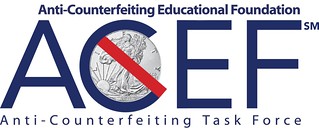 The Anti-Counterfeiting Educational Foundation’s Board of Directors has approved a $377,000 budget to
fund a robust public education program that includes presence on popular social media platforms such
as YouTube, Facebook, and Instagram as well as a greatly enhanced website featuring a “Trusted
Experts Directory,” and engagement in traditional print media.
The Anti-Counterfeiting Educational Foundation’s Board of Directors has approved a $377,000 budget to
fund a robust public education program that includes presence on popular social media platforms such
as YouTube, Facebook, and Instagram as well as a greatly enhanced website featuring a “Trusted
Experts Directory,” and engagement in traditional print media.
“We have to be pro-active in reaching out to people of all ages interested in buying precious metals coins and other numismatic collectibles and arm them with knowledge about how to avoid counterfeits and other scams that especially target uninformed buyers,” said ACEF President John Albanese. “Nobody wants to be defrauded. Unfortunately, people new to the marketplace that become victims of counterfeiters quickly lose interest and they miss out on good investments and the joys of a wonderful hobby,” Albanese added.
VOCABULARY TERM: PINBACK
Here's another entry from Dick Johnson's Encyclopedia of Coin and Medal Terminology. See also the article elsewhere in this issue on the Button Museum. -Editor
Pinback. A medallic item with some form of attachment, usually a straight pin on the reverse, so the item may be worn. Any small diestruck medallic item with some fastener, intended to be worn, could be considered to be a pinback. However the term pinback is so widely used for the celluloid pin (these are not diestruck thus outside the scope of this encyclopedia) that the term pin more often implies a medallic pin or jewelry pin. Medallic pinbacks can have design on both sides, but are usually uniface, with maybe only the maker’s mark on the side with the pin. The pinback usually has the maker's name on a paper label pasted on the back.
OSCAR GOTTLIEB SCHILKE (1903-1965)
E-Sylum Feature Writer and American Numismatic Biographies author Pete Smith submitted this article on author Oscar Schilke. Thanks! -Editor
If you were in Portsmouth, New Hampshire, in 1960, you could have gone to the Piscataqua State Bank to view the coin collection of “Nationally Famous Numismatist” Oscar G. Schilke. The exhibition was promoted with a quarter-page display ad in The Portsmouth Herald for April 26, 1960. Visitors were invited to see the collection, talk with Mr. Schilke and bring in coins and bills for a free appraisal. A 1952 ad in the Poughkeepsie Journal stated:
“The collection is comprised of old coins, medals, tokens and paper money dating back to early Roman and Greek coins of about 2000 years ago. It includes huge Swedish plate money; the first dated silver coins of 1484; early American Colonial oak and pine tree coins dated 1652; half-dimes dated 1792, the first coin minted in the United States mint with the portrait of Martha Washington engraved on the surface; the 1787 Fugio cent, the coin authorized by the U. S. Government and designed by Benjamin Franklin.”
CINCINNATI COLLECTOR HENRY CLAY EZEKIEL
Recently Pete Smith wrote about Henry Clay Ezekiel. Ezekiel was also the subject of an article Dave Schenkman published in the Summer 2017 issue of The Civil War Token Journal. With permission, we're republishing it here. Thanks! -Editor
David E. Schenkman
Over the years much has been written about the lives of prominent numismatists. Strangely, I have found very little concerning Henry Clay Ezekiel, who not only amassed a huge collection of tokens, medals, and paper money relating to Cincinnati, but also was acquainted with the die sinkers who were responsible for striking a significant percentage of all merchant tokens issued during the Civil War.
According to an article in the November, 1930 issue of The Numismatist, Ezekiel was born on January 30, 1846 in Richmond, Virginia. He attended the Lancasterian School in Richmond, and upon graduation enlisted in the Confederate Army. Following his discharge he moved to Cincinnati, Ohio, where he resided for the rest of his life.
SBG ACQUIRES WORLD BANKNOTE AUCTIONS
Stack’s Bowers Galleries has acquired World Banknote Auctions and brought founder Dennis Hengeveld on board. Congratulations to all. Here's the announcement. We'll look forward to Dennis's continued writing and cataloging of great numismatic material. -Editor
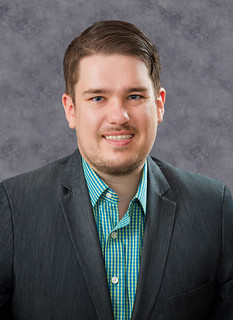 Stack’s Bowers Galleries, a global leader in numismatic auctions, proudly announces its
acquisition of substantially all the assets of World Banknote Auctions. This strategic move sees the integration of
World Banknote Auctions founder Dennis Hengeveld, a renowned authority in rare paper money and world coins,
into Stack’s Bowers Galleries’ distinguished team of specialists.
Stack’s Bowers Galleries, a global leader in numismatic auctions, proudly announces its
acquisition of substantially all the assets of World Banknote Auctions. This strategic move sees the integration of
World Banknote Auctions founder Dennis Hengeveld, a renowned authority in rare paper money and world coins,
into Stack’s Bowers Galleries’ distinguished team of specialists.
“Under the leadership of Dennis Hengeveld, World Banknote Auctions has achieved remarkable growth, with total auction prices realized surpassing $7 million in 2023,” said Brian Kendrella, President of Stack’s Bowers Galleries. “The acquisition of World Banknote Auctions and the addition of Dennis to our team underscores our dedication to the rare paper money category. Not only does it expand our offerings of rare notes for auction, but it also brings aboard one of the foremost paper money authorities and numismatic entrepreneurs, enhancing our roster of prominent experts.”
DONIVAN FLOYD WINS 2024 PNG SCHOLARSHIP
PNG has announced the winner of their 2024 PNG Scholarship. -Editor
 A young numismatist from Coeur D’ Alene, Idaho, Donivan Floyd, 19, is the winner of the 2024 Professional Numismatists Guild’s (www.PNGdealers.org) annual scholarship award competition.
A young numismatist from Coeur D’ Alene, Idaho, Donivan Floyd, 19, is the winner of the 2024 Professional Numismatists Guild’s (www.PNGdealers.org) annual scholarship award competition.
The PNG scholarship will cover airfare, tuition for one of the two June 2024 American Numismatic Association (www.money.org) Summer Seminar sessions, meals, and dormitory accommodations on the campus of Colorado College, adjacent to the ANA headquarters,” said PNG Executive Director John Feigenbaum.
Floyd grew up in a coin shop, DJ’s Coins & Collectables owned by his father David J. Floyd, but only began collecting five years ago at the age of 14.
NUMISMAGRAM MEDAL SELECTIONS: APRIL 21, 2024
Numismagram's Jeremy Bostwick sent along these four items from his most recent upload of new material to his site. This upload featured a complete run of Jacques Wiener's initial architectural series of Belgian churches, along with a few other architectural types. For all of the new items, please visit https://www.numismagram.com/inventory.
From what is today eastern Netherlands and western Germany, the Wieners were a Jewish family of exceptional medalists, especially known for numerous numismatic works throughout the Kingdom of Belgium. Eldest brother Jacques, along with younger brothers Leopold and Charles, created some of the finest works of medallic art of the 19th century, and all are particularly noted for their highly detailed and intricate work, especially that of Jacques with respect to architectural renderings -Editor
102781 | BELGIUM. Bruges. Cathedral of St. Sauveur bronze Medal. Issued 1846. Churches of Belgium series (50mm, 53.6 g, 12h). By J. Wiener and struck at the Geerts mint in Ixelles. FONDÉE PAR ST. ELOI ÉVÊQUE DE NOYON 652 INCENDIÉE AU DOUZIÈME SIECLE / REBATIE ET CONSACRÉE 1127. UNE SECONDE FOIS INCENDIÉE 1358. LA TOUR RECONSTRUITE 1846. / RENFERME LES RESTES DE CHARLES LE BON / ÉGLISE ST. SAUVEUR / À BRUGES, perspective exterior view of the cathedral // Perspective interior view, from a vantage point just left of center. Edge: Plain. Ross M22; van Hoydonck 20; Reinecke 3. Gem Mint State, rich red-brown surfaces, with some lustrous brilliance remaining. $365.
To read the complete item description, see:
102781 | BELGIUM. Bruges. Cathedral of St. Sauveur bronze Medal.
(https://www.numismagram.com/product-page/102781)
WAYNE'S NUMISMATIC DIARY: APRIL 21, 2024
 On Tuesday April 16, 2024 I hurried out of the office to head toward Alexandria for the monthly dinner meeting of my Northern Virginia Numismatic Social group, Nummis Nova. Our special guests for the evening were my old friend and E-Sylum contributor Kavan Ratnatunga and his wife Lidwina. They'd travelled to the U.S. from Sri Lanka to view the total eclipse in Dallas, and were now in the Washington, D.C. area visiting friends. They had been touristing in D.C. for a couple of days when I picked them up outside the Alexandria Old Town Metro Station.
On Tuesday April 16, 2024 I hurried out of the office to head toward Alexandria for the monthly dinner meeting of my Northern Virginia Numismatic Social group, Nummis Nova. Our special guests for the evening were my old friend and E-Sylum contributor Kavan Ratnatunga and his wife Lidwina. They'd travelled to the U.S. from Sri Lanka to view the total eclipse in Dallas, and were now in the Washington, D.C. area visiting friends. They had been touristing in D.C. for a couple of days when I picked them up outside the Alexandria Old Town Metro Station.
It was great to see Kavan again over thirty years since we'd met at meetings of the Pittsburgh Numismatic Society on the campus of the University of Pittsburgh. Kavan was an astrophysicist at nearby Carnegie Mellon University, working with data from the Hubble Space Telescope. Traveling the globe to experience a celestial phenomena is perfectly in character. Here's the photo he posted on Facebook of the Total Solar Eclipse on 2024 April 8th, taken from south west of Dallas, TX.
DORSET ENGLISH CIVIL WAR COIN HOARD
Not all coin hoards are from ancient Rome. Here's a BBC story about a find of a hoard deposited early in the English Civil War. -Editor
The cache of more than 1,000 gold and silver coins was discovered under an earth floor at South Poorton, Dorset.
One of the property's new owners, Robert Fooks, was digging with a pickaxe by torchlight when he found the trove in a pottery bowl.
Auctioneers hope to sell the collection for between £15,000 and £30,000.
COLLECTING COINS FROM TRASH
Paul Horner passed along this Wall Street Journal article about how waste processing companies recover millions of dollars worth of coins from trash. Thanks also to Justin Perrault, Dave Perkins and Len Augsburger. Great story. When you look in enough old couch cushions, the finds add up. -Editor
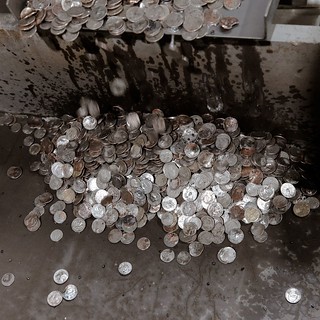 At a waste-management facility in Morrisville, Pa., workers load incinerated trash into industrial machinery that separates and sorts metals, then sends them to get hosed down. The reward: buckets of quarters, dimes, nickels and pennies.
At a waste-management facility in Morrisville, Pa., workers load incinerated trash into industrial machinery that separates and sorts metals, then sends them to get hosed down. The reward: buckets of quarters, dimes, nickels and pennies.
Americans toss as much as $68 million worth of change each year, according to Reworld. The sustainable-waste processing company is on a treasure-hunt to find it. The company says that in the seven years since it started th
Coins are as good as junk for many Americans. Buses, laundromats, toll booths and parking meters now take credit and debit cards and mobile payments. Using any form of physical currency has become more of an annoyance, but change is often more trouble than it is worth to carry around. The U.S. quarter had roughly the buying power in 1980 that a dollar has today.
PAVING A FLOOR WITH COINS
The Wall Street Journal article about recovering coins from trash included a sidebar piece on using coins to pave a floor. -Editor
This year, Sara and Justin Ilse finished building a floor for their home’s 230-square-foot entryway out of 65,507 pennies.
“It was a way to encase something that doesn’t get viewed with much value in daily life,” Justin said.
More than 20,000 of the pennies came from jars that Sara’s father and brother-in-law kept in their closets. They bought the rest of the pennies they needed in 2,500 increments through their local bank. In addition to the $655 they spent on pennies, they also spent $1,195 on supplies such as glue and epoxy.
GOLD, SILVER, AND THE ELUSIVE GOLD STANDARD
Pablo Hoffman passed along this Delancey Place blog article with an excerpt from The Money Kings by Daniel Schulman. Thanks. -Editor
“The United States had operated on the bimetallic standard prior to the Civil War, when the cash-strapped Lincoln administration began printing greenbacks. But when Ulysses Grant signed the Coinage Act of 1873, drastically limiting the minting of silver-based currency, he had placed the nation on the path to adopting the gold standard alone, as many European nations had already done and as others would do in the years to follow.
NEPAL CROP MAKES JAPANESE BANKNOTE PAPER
Pablo Hoffman also passed along this article about the making of paper for Japanese banknotes. Thanks - interesting. -Editor
Nepal’s unique ecological diversity and topography gives the country many cash crops, but there is one crop that is actually turned into cash.
In recent years, there has been a dramatic rise in exports of the bark of a Himalayan bush, Edgeworthia gardneri, prized in Japan to print currency notes, passports, envelopes, postage stamps, and other stationery.
ZIMBABWE GOLD NOTES INTRODUCED
In the here-we-go-again department, Zimbabwe is issuing yet another new version of its' inflated currency. -Editor
Zimbabwe’s recently introduced gold-backed currency is sliding on the local black market but officials insist the currency is getting stronger and has a bright future. Columbus Mavhunga reports from Harare.
Even songs are played on the radio encouraging citizens to embrace the currency, called Zimbabwe Gold — or ZiG — introduced on April 5 trading at 13.56 to the U.S. dollar.
Official statistics say ZiG is now trading at 13.41. But on the black market it is around 20.
SINGAPORE STARTUP'S PHYSICAL BITCOIN BANKNOTES
Physical bitcoins have been around for some time and are now collectibles. Physical bitcoin banknotes are less common. Time will tell if any of them catch on. Before anyone notices, let me note upfront that this news is a few years old - it just popped up for some reason in a Google alert. The company still exists and their website is active, with a new blog article posted just this week. -Editor
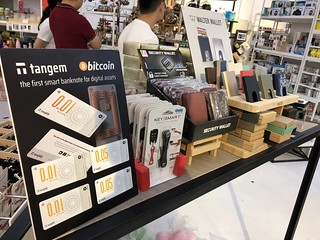 A Singaporean startup developing ‘smart banknotes’ for cryptocurrencies has launched sales of physical bitcoin banknotes with a pilot in a major Singaporean mall.
A Singaporean startup developing ‘smart banknotes’ for cryptocurrencies has launched sales of physical bitcoin banknotes with a pilot in a major Singaporean mall.
Describing itself as a ‘smart banknote platform’ that manufactures physical notes with denominated values of cryptocurrencies like bitcoin, Singaporean firm Tangem has debuted ‘Tangem Note(s)’ in a pilot launch at the Suntech City shopping center in the city-state today.
THE HISTORY AND FUTURE OF THE CFA FRANC
Pablo Hoffman passed along this article with background on the CFA franc, a common currency in 14 African countries, created in 1945. -Editor
The CFA franc zone was founded by then colonial power France after the second world war. Its aim was to ensure a continuously cheap influx of resources into France.
The zone is divided into two. The west African CFA franc zone has eight members: Mali, Niger, Burkina Faso, Senegal, Côte d'Ivoire, Benin, Togo and Guinea-Bissau. The central African zone has six: Cameroon, Gabon, Republic of Congo, Central African Republic, Chad and Equatorial Guinea.
Popular mobilisation against the currency has been intense in recent years in west Africa.
NEW PORTRAIT IDEAS FOR U.S. CURRENCY
Wayne Pearson writes:
"Maybe DEI (Diversity, equity, and inclusion) isn’t all bad. It would be nice to see some 21st century paper money. All of the people on our paper money have been there for 95 years, starting in 1929. The most contemporary of them is Grant, who died in 1885. Here is a look at a new idea."
JAPANESE MONEY ARTIST KATSUHIKO AKASEGAWA
This article mentions Japanese money artist Katsuhiko Akasegawa, also known as Genpei. Found via News & Notes from the Society of Paper Money Collectors (Volume IX, Number 44, April 16, 2024). -Editor
Among them was a 43-year-old artist named Katsuhiko Akasegawa, known in the art world as Genpei. Besides being a Giants fan, Akasegawa was one of the brightest avant-garde figures in postwar Japanese art. His most famous work was a series of 1,000-yen banknotes, which he did not consider as counterfeit currency but as “a mock-up of banknotes, just as a model of an airplane is not an airplane.” Despite this explanation, the authorities ended up taking him to court.
During the trial, Genpei insisted that the banknotes were art, turning his appearance in court into a performance in which he and other contemporary artists reflected on the meaning of art. In the end, and after several appeals, the Supreme Court of Japan gave Akasegawa a suspended three-month sentence in 1970; in other words, he did not go to jail and, in fact, his banknote-prints soared in popularity to the point that they are currently exhibited at the MoMA in New York.
LOOSE CHANGE: APRIL 21, 2024
Here are some additional items in the media this week that may be of interest. -Editor
In the monetary-chicken-and-egg department, this article asks which came first: barter or money. -Editor
Adam Smith tried to tell us that money was not invented by governments. Money, and economic life entire, come from “a certain propensity in human nature,” he says, “the propensity to truck, barter, and exchange one thing for another.” Smith gives a detailed account of how such barter might arise in a group of shepherds or hunters. He does not pretend that this is an actual group of which he has actual knowledge. But what genre of story is this then?
Although many economists have told the “money comes from barter” story as nonfiction, contemporary economics textbooks tell it neither as fact nor fiction, but as a hypothetical. To see the benefits of money, one textbook advises, “imagine a barter economy.” “In a complex society with many goods,” says another, money replaces barter, since “barter exchanges involve an intolerable amount of effort.” More poetically, one textbook asks us to imagine that we “have roosters, but…want roses.”
The trouble is, as anthropologist Caroline Humphrey points out, “No example of a barter economy, pure and simple, has ever been described, let alone the emergence from it of money; all available ethnography suggests that there never has been such a thing.” Never?
Barter societies, where they exist at any scale, are what happens (initially, briefly) to societies that once used money after their central government collapses. So, while economists would have you believe that barter initially arises from “a certain propensity in human nature,” but that, given barter’s intolerable complexity, barter gives rise naturally to money, and that the use of money leads to credit and debt, David Graber argues that, basically, the opposite is true.
To read the complete article, see:
Dream Of Money
(https://3quarksdaily.com/3quarksdaily/2024/04/dream-of-money.html)
Other topics this week include Longacre's Indian Princess dollars, and gold smuggling. -Editor
THE BUTTON MUSEUM
We sometimes discuss other collectible fields as a way of understanding overall trends. I've always felt predictions of hobby death were overblown. Collecting seems to be an innate human desire. Not all of us, mind you - one is either born a collector or not. But new collectors are born every day, carrying their newfound hobbies into the future. Here's a pair of Chicago siblings who make, collect and write about buttons.
See also the article elsewhere in this issue on the definition of pinback. -Editor
By Christen Carter and Ted Hake
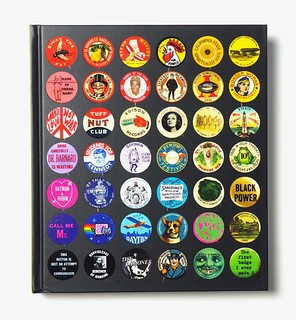 From the campaign trail to the rock tour, BUTTON POWER (Princeton Architectural Press) collects a people's history of American culture told through the pin-back button. Lively commentary from two of America's foremost button experts shows how the small but powerful button reveals the events and movements that outraged, amused, and inspired us over time, from the solo flight of Charles Lindbergh to the Black Power movement. Artists, athletes, actors, politicians, punk and pop musicians, and mascots of the past 125 years make cameos, including Rube Goldberg, Muhammad Ali, the Ramones, Shirley Chisholm, and Bette Midler are all covered in this book!
From the campaign trail to the rock tour, BUTTON POWER (Princeton Architectural Press) collects a people's history of American culture told through the pin-back button. Lively commentary from two of America's foremost button experts shows how the small but powerful button reveals the events and movements that outraged, amused, and inspired us over time, from the solo flight of Charles Lindbergh to the Black Power movement. Artists, athletes, actors, politicians, punk and pop musicians, and mascots of the past 125 years make cameos, including Rube Goldberg, Muhammad Ali, the Ramones, Shirley Chisholm, and Bette Midler are all covered in this book!
The first book of its kind, BUTTON POWER is a rich visual feast showcasing over 1,500 buttons. You can see how design and messaging have been used spanning over a century!


